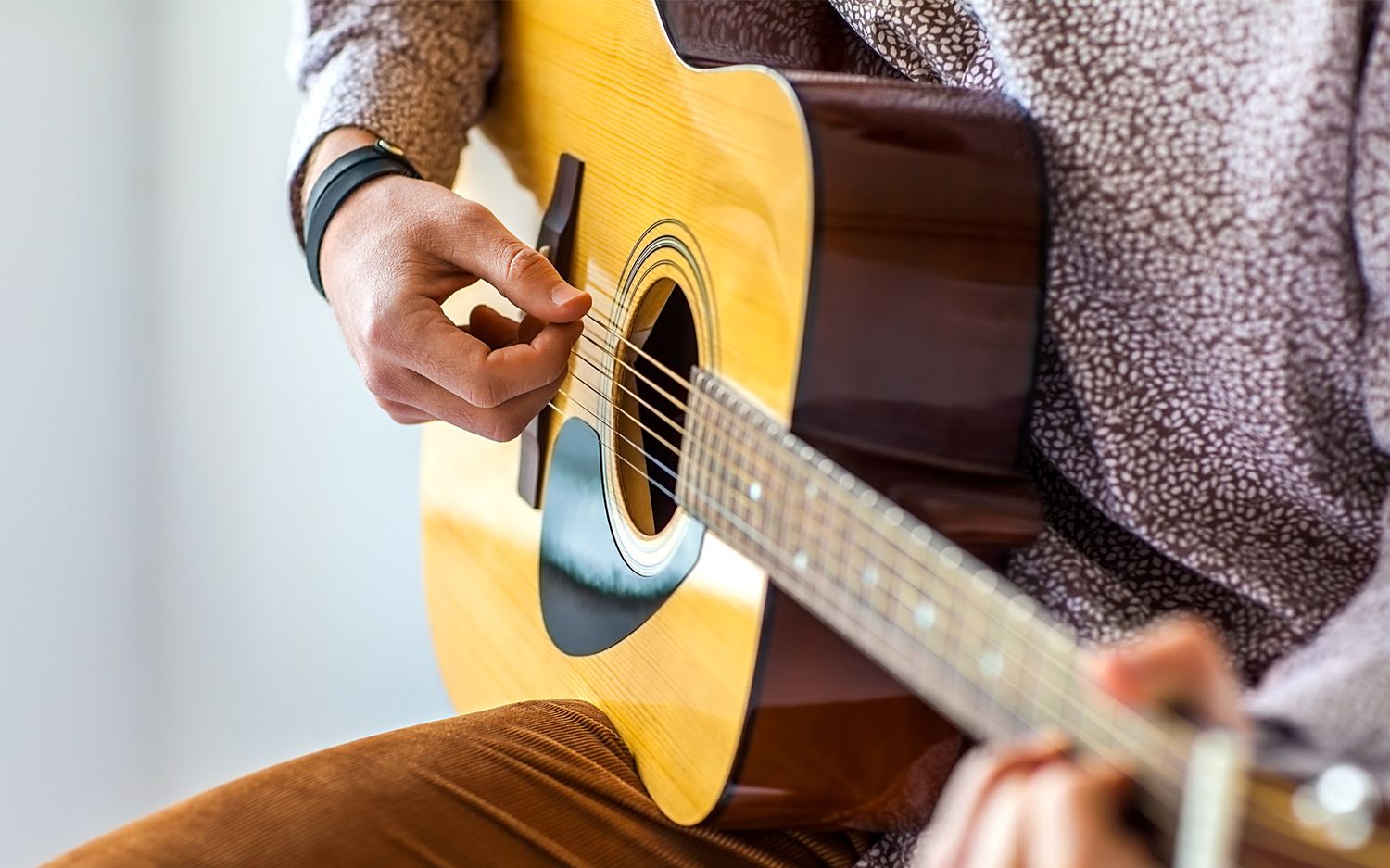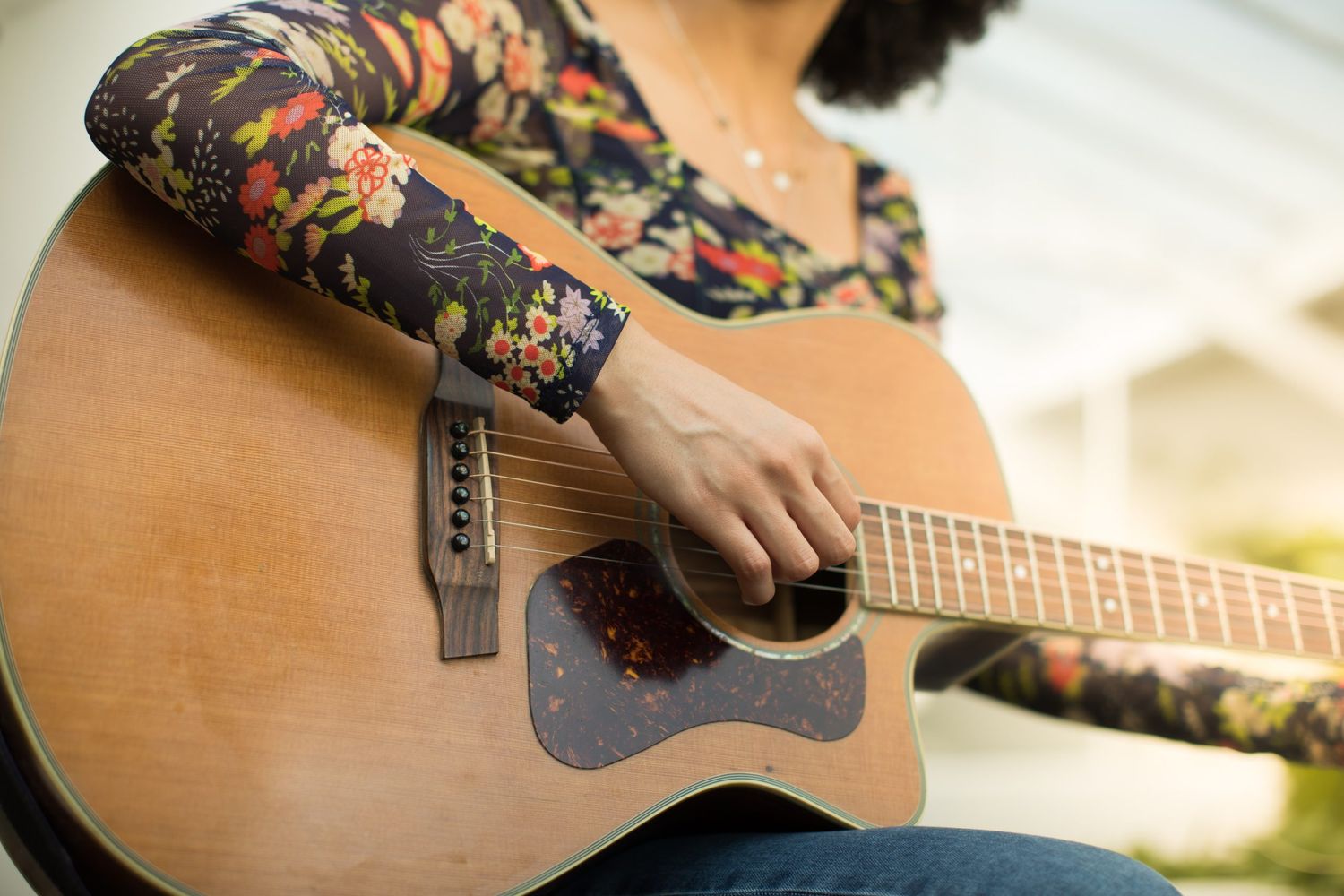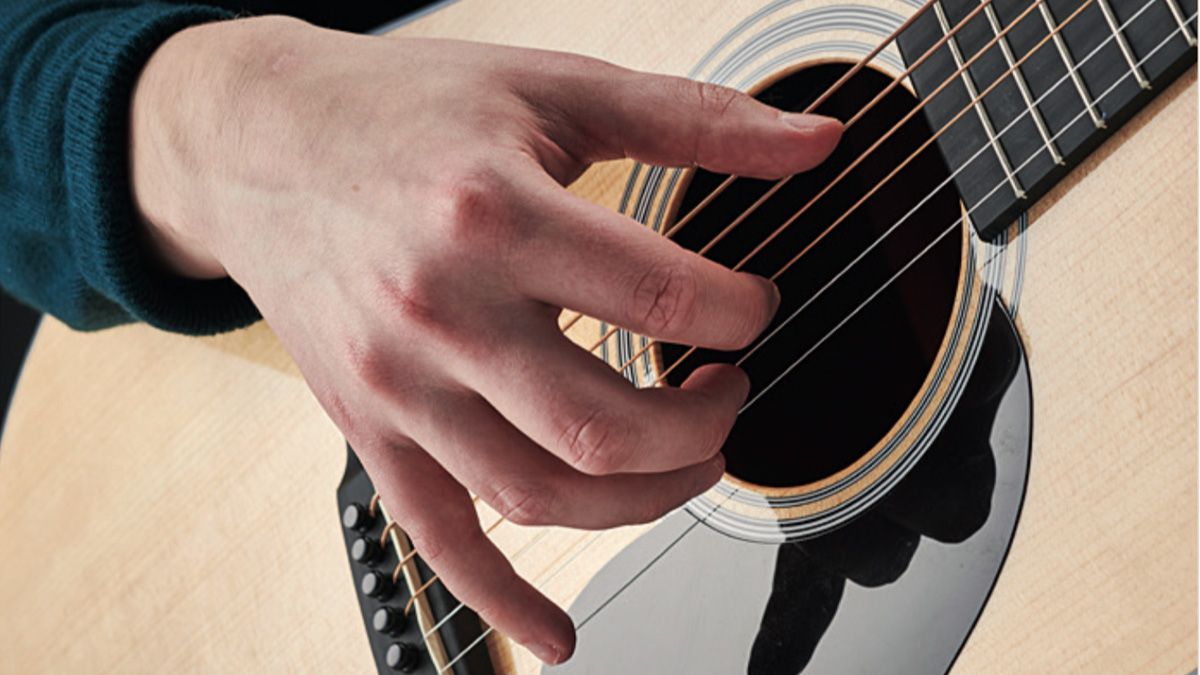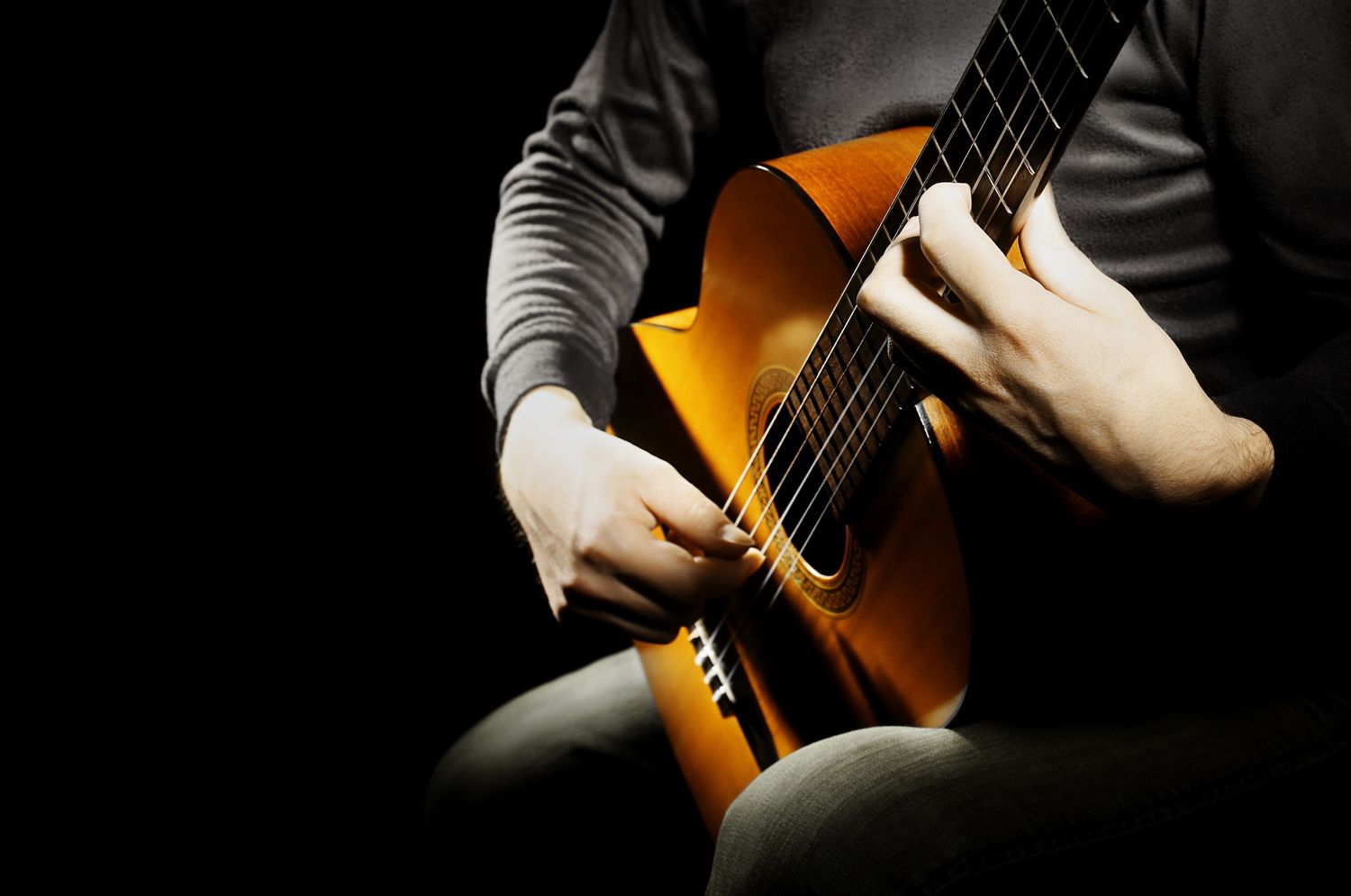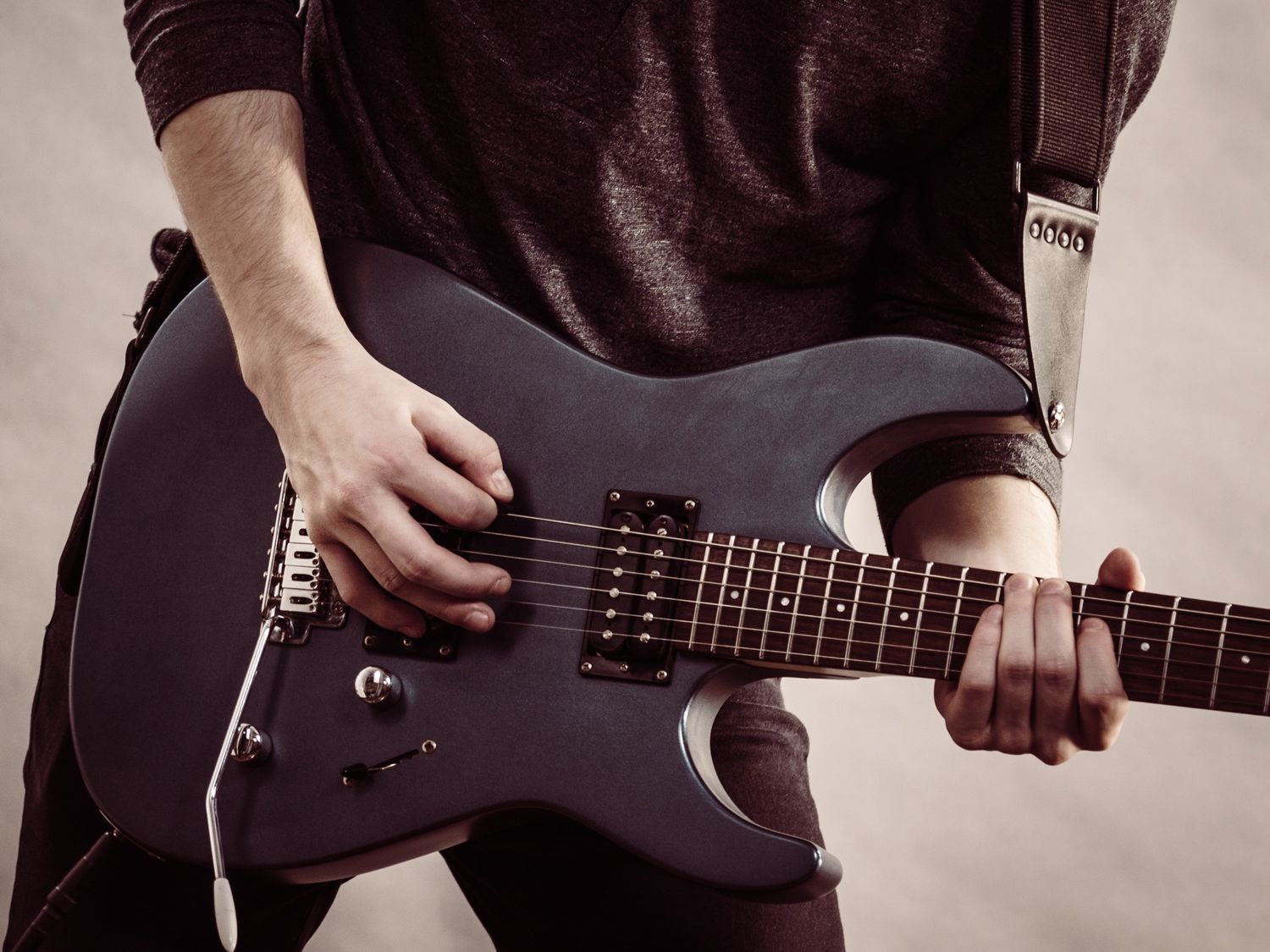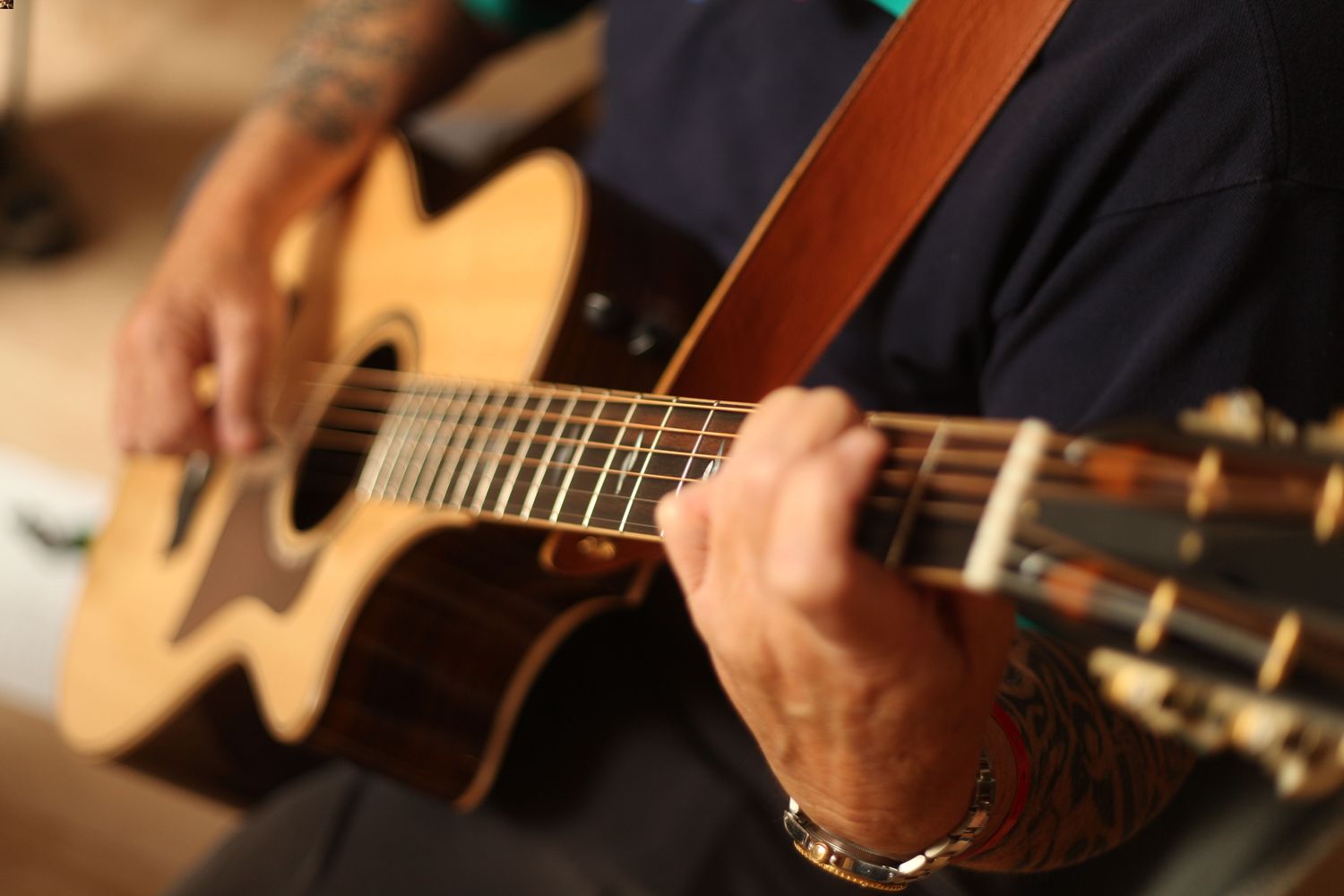Home>Instruments>Guitar>How To Play A Guitar


Guitar
How To Play A Guitar
Modified: February 15, 2024
Learn how to play a guitar with our comprehensive guide. Master chords, scales, and techniques to become a skilled guitarist. Start your musical journey today!
(Many of the links in this article redirect to a specific reviewed product. Your purchase of these products through affiliate links helps to generate commission for AudioLover.com, at no extra cost. Learn more)
Table of Contents
Introduction
So, you want to learn how to play the guitar? That's fantastic! The guitar is a versatile and expressive instrument that can be found in nearly every genre of music, from rock and pop to blues, jazz, and classical. Whether you're drawn to the raw power of an electric guitar riff or the gentle, melodic strumming of an acoustic guitar, learning to play this instrument can be an incredibly rewarding experience.
Playing the guitar is not only a great way to express yourself creatively, but it also offers a range of mental and emotional benefits. It can improve your memory, enhance your concentration, and reduce stress. Plus, mastering the guitar can open up opportunities for socializing and collaboration with other musicians.
Before you dive into the world of guitar playing, it's important to understand that learning any musical instrument requires patience, dedication, and practice. While it may seem daunting at first, with the right guidance and a positive mindset, you can absolutely learn to play the guitar.
In this comprehensive guide, we'll walk you through the essential steps to get started on your guitar-playing journey. From choosing the right guitar to mastering fingerpicking techniques and exploring different playing styles, we've got you covered. By the end of this guide, you'll have a solid foundation to build upon as you continue to develop your skills and musicality on the guitar.
So, grab your guitar, get comfortable, and let's embark on this exciting musical adventure together!
Choosing the Right Guitar
When it comes to choosing a guitar, there are a few key factors to consider to ensure that you find the right instrument for your needs and preferences. The two primary types of guitars are acoustic and electric, each with its own unique sound and playing experience.
If you’re drawn to the warm, natural tones of acoustic music or the idea of being able to play anywhere without needing an amplifier, an acoustic guitar may be the perfect choice for you. On the other hand, if you’re inspired by the electrifying sounds of rock, blues, or jazz, an electric guitar might be more in line with your musical aspirations.
Once you’ve decided between acoustic and electric, it’s time to consider the body style of the guitar. Acoustic guitars come in various body shapes, such as dreadnought, concert, and jumbo, each offering distinct tonal characteristics and ergonomic features. Electric guitars also have different body styles, including solid body, hollow body, and semi-hollow body, each contributing to the instrument’s sound and playability.
Another crucial aspect to ponder is the neck profile and width. The neck of the guitar significantly impacts playability, especially for beginners. A slimmer neck may be more comfortable for those with smaller hands, while a broader neck can provide more room for intricate fingerings and chord shapes.
Furthermore, the choice of tonewoods can influence the guitar’s sound. Common tonewoods for acoustic guitars include spruce, mahogany, and cedar, each contributing to the instrument’s resonance and timbre. Electric guitars often feature tonewoods like maple, mahogany, and ash, which can affect the guitar’s sustain and overall tonal characteristics.
Ultimately, the best way to choose the right guitar is to play as many instruments as possible to get a feel for their sound, playability, and comfort. Whether you opt for an acoustic or electric guitar, finding a guitar that resonates with you both sonically and ergonomically is essential to embarking on a fulfilling musical journey.
Understanding the Guitar
Before diving into playing the guitar, it’s beneficial to familiarize yourself with the instrument’s anatomy and basic components. Understanding the various parts of the guitar will not only enhance your playing experience but also empower you to communicate effectively with other musicians and guitar technicians.
The main components of a standard acoustic or electric guitar include the body, neck, headstock, fretboard, frets, bridge, and tuning pegs. The body of the guitar, which houses the sound hole in acoustic guitars or the pickups in electric guitars, contributes significantly to the instrument’s resonance and tonal characteristics.
The neck of the guitar extends from the body and is where the fretboard and frets are located. The fretboard is typically made of wood, such as rosewood or maple, and is divided into frets, which are the metal strips embedded along the length of the fretboard. Pressing the strings against the frets enables the player to change the pitch of the notes, allowing for the creation of melodies, chords, and intricate musical phrases.
The headstock, situated at the end of the neck, houses the tuning pegs, which are used to adjust the tension of the strings, thereby tuning the guitar to the desired pitches. Understanding how to tune the guitar is essential for maintaining accurate pitch and harmony while playing.
Additionally, it’s valuable to grasp the concept of string numbering and standard tuning. In standard tuning, the strings are tuned to the pitches E, A, D, G, B, and E, from the lowest-pitched string to the highest. Each string corresponds to a specific musical note, and familiarizing yourself with their order and pitch will facilitate chord formations and scale patterns.
By gaining a foundational understanding of the guitar’s structure and functionality, you’ll be better equipped to navigate the instrument with confidence and ease. Moreover, recognizing the role of each component will deepen your appreciation for the craftsmanship and engineering that goes into creating these timeless musical tools.
Tuning the Guitar
Tuning your guitar is a fundamental skill that directly impacts the sound and playability of the instrument. A well-tuned guitar ensures that the pitches of the strings are in harmony with one another, allowing you to play chords, melodies, and songs with accuracy and clarity. While there are various methods and tools for tuning a guitar, the most common and essential approach is standard tuning, which involves setting the strings to the pitches E, A, D, G, B, and E, from the lowest-pitched string to the highest.
One of the most popular tuning methods is using a chromatic tuner, a device that detects the pitch of each string and provides visual or auditory feedback to guide you in achieving the correct tuning. Alternatively, tuning the guitar by ear is a valuable skill that can be developed over time through exposure to musical pitches and consistent practice.
When tuning by ear, it’s helpful to reference a reliable pitch source, such as a piano, pitch pipe, or another tuned instrument, to ensure that your guitar strings are accurately set to the intended pitches. By comparing the sound of each open string to the corresponding note on the reference source, you can adjust the tuning pegs on the headstock to raise or lower the pitch until it matches the desired note.
Another approach to tuning involves using harmonics, which are bell-like tones produced by lightly touching the strings at specific nodal points and plucking them to generate a pure, sustained pitch. By comparing and adjusting the harmonics of different strings, you can fine-tune the guitar to achieve precise intonation and harmonic balance across the fretboard.
It’s important to note that frequent playing, changes in temperature and humidity, and the natural elasticity of the strings can cause the guitar to drift out of tune. Therefore, regular tuning maintenance is essential to keep the instrument sounding its best.
Whether you choose to tune your guitar using a digital tuner, by ear, or through harmonic methods, developing a keen ear for pitch and mastering the art of tuning will significantly enhance your playing experience and musical proficiency. A well-tuned guitar is not only a joy to play but also sets the stage for creating beautiful music that resonates with precision and clarity.
Basic Guitar Techniques
As you embark on your guitar-playing journey, familiarizing yourself with fundamental techniques is essential for building a strong foundation and developing your skills as a musician. These techniques form the building blocks for playing melodies, chords, and various musical styles on the guitar.
One of the first techniques to master is proper fretting hand placement. When fretting notes and chords, use the tips of your fingers to press the strings against the fretboard, ensuring clear and consistent contact to produce clean, resonant tones. Additionally, maintaining a relaxed yet firm grip on the neck of the guitar will facilitate smooth transitions between notes and chords.
Concurrently, refining your picking or strumming hand technique is crucial. Whether using a pick or playing fingerstyle, focus on achieving a balanced and controlled motion when striking the strings. Experiment with different pick gauges and materials to find the right fit for your playing style, and explore various strumming patterns to add dynamic rhythm and texture to your playing.
Another fundamental technique is understanding the concept of fretting hand dexterity and finger independence. Practicing scales, such as the pentatonic scale or the major scale, can enhance finger strength, agility, and coordination, laying the groundwork for fluid and effortless fretboard navigation.
Moreover, familiarizing yourself with basic chord shapes and voicings is essential for accompanying songs and creating harmonic progressions. Start with foundational open chords like C, G, D, E, and A, gradually expanding your chord vocabulary to include barre chords, power chords, and extended voicings as you progress.
Developing a keen sense of rhythm and timing is equally important. Experiment with playing along to a metronome or drum track to internalize rhythmic patterns and improve your overall sense of groove and timing. Understanding rhythmic notation and strumming patterns will enable you to interpret and play a wide range of musical styles with confidence.
By mastering these basic techniques and incorporating them into your practice routine, you’ll lay a solid groundwork for your guitar-playing journey. Consistent practice, patience, and a willingness to explore new musical horizons will pave the way for continued growth and proficiency as a guitarist.
Learning Chords
Chords are the backbone of guitar playing, allowing you to accompany songs, create harmonic textures, and express musical ideas with depth and richness. Mastering a diverse array of chords is pivotal for expanding your musical repertoire and unlocking the potential for creative expression on the instrument.
Begin by familiarizing yourself with essential open chords, such as C, G, D, E, and A. These foundational chords form the basis of countless songs across various genres and serve as an entry point for understanding chord construction and finger placement on the fretboard.
As you progress, venture into barre chords, which involve using a single finger to fret multiple strings across the fretboard. Barre chords are movable shapes, allowing you to play the same chord in different positions, thereby expanding your harmonic palette and facilitating melodic movement within chord progressions.
Furthermore, delve into power chords, which are versatile and prevalent in rock, punk, and metal music. Power chords, consisting of the root note and its fifth, are characterized by their robust and aggressive sound, making them a staple in rhythm guitar playing and energetic musical contexts.
Exploring extended and altered chords, such as seventh chords, ninth chords, sus2, and sus4 chords, will add color and sophistication to your playing. These chords introduce nuanced harmonic nuances and can evoke a range of emotions, from melancholy and introspection to jubilance and exuberance.
Understanding chord progressions, which are sequences of chords that form the harmonic framework of a song, is essential for songwriting, improvisation, and interpreting musical compositions. By studying common chord progressions, such as the I-IV-V progression or the ii-V-I progression, you’ll gain insight into the structural and emotional dynamics of music.
As you delve into the world of chords, remember that patience and consistent practice are key. Gradually integrating new chord shapes and progressions into your playing will expand your musical vocabulary and empower you to convey your artistic vision with depth and resonance.
Playing Scales
Mastering scales is a fundamental aspect of guitar playing that not only enhances technical proficiency but also fosters musical creativity and improvisational skills. Scales provide a structured framework for understanding melody, harmony, and the relationship between notes, laying the groundwork for expressive and articulate guitar playing.
One of the most essential scales for guitarists to learn is the pentatonic scale. Renowned for its versatility and widespread application in various musical genres, the pentatonic scale is a five-note scale that offers a melodic foundation for soloing, improvisation, and crafting memorable guitar licks.
Furthermore, exploring the major scale and its modes, such as the Ionian, Dorian, and Mixolydian modes, expands your melodic horizons and equips you with a diverse palette of tonal colors to draw from in your playing. Understanding the intervals, fingerings, and musical characteristics of these scales broadens your melodic vocabulary and fosters a deeper connection with the fretboard.
Delving into the realm of minor scales, including the natural minor scale, harmonic minor scale, and melodic minor scale, opens doors to emotive and evocative musical expressions. These scales evoke a wide range of moods, from introspective and haunting to passionate and poignant, allowing you to convey profound emotions through your guitar playing.
Developing proficiency in scale sequences and patterns, such as three-note-per-string patterns and diagonal fingerings, enhances your technical agility and facilitates fluid, seamless movement across the fretboard. These patterns serve as vehicles for melodic exploration, enabling you to traverse the guitar with precision and grace.
Moreover, integrating scale exercises, such as alternate picking, legato, and string skipping, into your practice regimen cultivates dexterity, control, and dynamic expression in your playing. Consistent practice of these exercises refines your technique and fortifies your ability to articulate musical ideas with clarity and finesse.
As you immerse yourself in the world of scales, remember that the ultimate goal is not just technical mastery but the ability to convey emotion, tell stories, and connect with your audience through your playing. Embrace the journey of scale mastery with curiosity and dedication, and you’ll unlock a world of melodic possibilities on the guitar.
Developing Rhythm
Rhythm is the heartbeat of music, and developing a strong sense of rhythm is essential for becoming a proficient guitarist. It is the foundation upon which melodies and harmonies are built, and mastering rhythm empowers you to drive the musical momentum, infuse energy into your playing, and synchronize seamlessly with other musicians.
One of the most effective ways to cultivate rhythm is by practicing with a metronome. A metronome serves as a steady pulse, helping you internalize rhythmic patterns, maintain consistent tempo, and refine your timing. Start by practicing simple chord progressions or scales in time with the metronome, gradually increasing the tempo as your comfort level grows.
Another valuable approach to developing rhythm is to explore different time signatures and rhythmic subdivisions. Experiment with playing in 4/4, 3/4, 6/8, and other time signatures to expand your rhythmic versatility and adaptability. Additionally, practicing rhythmic subdivisions, such as eighth notes, triplets, and sixteenth notes, hones your precision and fluency in navigating diverse rhythmic textures.
Embracing syncopation, which involves accenting offbeat rhythms, injects vitality and dynamism into your playing. By integrating syncopated patterns into your strumming or picking technique, you can create compelling rhythmic tension and release, adding depth and groove to your musical phrases.
Furthermore, studying rhythmic notation and understanding rhythmic symbols, rests, and ties equips you with the literacy to interpret and communicate rhythmic ideas effectively. This knowledge enhances your ability to collaborate with other musicians, read sheet music, and articulate rhythmic nuances in your playing.
Collaborating with a drummer, percussionist, or backing tracks provides invaluable opportunities to develop your sense of ensemble playing and lock into a cohesive rhythmic groove. Playing alongside other musicians fosters an intuitive understanding of interlocking rhythms, call-and-response dynamics, and the art of musical conversation.
Ultimately, developing rhythm is not just about technical precision but also about internalizing the pulse of the music and infusing it with your unique expression. Embrace rhythm as a foundational element of your musical identity, and let it propel your guitar playing to new heights of dynamism and vitality.
Mastering Fingerpicking
Fingerpicking is a versatile and expressive technique that adds a layer of intricacy and nuance to your guitar playing. Whether you’re drawn to folk, blues, classical, or contemporary acoustic music, mastering fingerpicking opens the door to a rich tapestry of melodic possibilities and rhythmic textures.
Begin by familiarizing yourself with the basic fingerpicking patterns, such as the alternating bass pattern and the arpeggio pattern. These foundational patterns form the bedrock of fingerstyle playing, enabling you to simultaneously pluck the strings with your fingers to create melodic and harmonic interplay.
As you delve deeper into fingerpicking, explore the concept of fingerstyle arrangements, where you adapt songs and melodies for solo guitar performance. By incorporating bass notes, chordal textures, and melodic motifs into your fingerstyle arrangements, you can transform familiar tunes into captivating and evocative solo pieces.
Studying the works of renowned fingerstyle guitarists, such as Tommy Emmanuel, Chet Atkins, and Andy McKee, provides inspiration and insight into the boundless potential of fingerpicking. Analyze their techniques, study their arrangements, and draw from their artistic approaches to enrich your own fingerstyle repertoire.
Experiment with fingerpicking exercises that focus on finger independence, control, and agility. These exercises, which often involve plucking individual strings with different fingers, enhance your dexterity and precision, allowing you to navigate complex fingerstyle passages with grace and fluency.
Exploring alternate tunings, such as DADGAD or Open D, can yield a wealth of harmonic and tonal possibilities for fingerstyle playing. These tunings offer unique voicings and resonances, inspiring fresh melodic ideas and expanding the sonic palette of your fingerpicking repertoire.
Moreover, integrating percussive elements, such as tapping, slapping, and percussion effects, into your fingerstyle technique adds rhythmic vitality and percussive flair to your playing. These percussive techniques infuse your fingerstyle arrangements with dynamic rhythmic accents and textural diversity.
Approach fingerpicking with patience and dedication, allowing yourself the time to internalize the intricate interplay of melody, harmony, and rhythm. Embrace the art of fingerstyle as a journey of self-expression and musical storytelling, and let your fingers weave a tapestry of emotive and captivating guitar music.
Exploring Different Styles
One of the most captivating aspects of playing the guitar is the vast array of musical styles that it encompasses. From the raw power of rock and the soulful expressiveness of blues to the intricate fingerstyle of folk and the technical prowess of jazz, exploring different styles on the guitar opens doors to diverse sonic landscapes and artistic expressions.
Begin by immersing yourself in the foundational elements of each style. For example, if you’re drawn to the blues, familiarize yourself with the 12-bar blues progression, blues scales, and the expressive bends and vibrato techniques that define the genre’s emotive playing style.
Delve into the world of rock guitar playing by studying power chords, palm muting, and iconic rock riffs. Experiment with distortion and overdrive effects to craft searing lead lines and dynamic rhythm parts that capture the essence of rock’s electrifying energy.
For those intrigued by the melodic intricacies of jazz, explore chord melody arrangements, jazz voicings, and improvisational techniques. Dive into the world of jazz standards and learn to navigate complex chord changes and harmonic progressions with finesse and sophistication.
Venture into the realm of fingerstyle playing to discover the evocative beauty of folk and acoustic music. Embrace open tunings, intricate fingerpicking patterns, and emotive storytelling through the guitar, capturing the essence of folk traditions and contemporary acoustic expressions.
Furthermore, exploring world music styles, such as flamenco, bossa nova, and Celtic music, introduces you to unique rhythmic patterns, exotic scales, and cultural influences that enrich your musical vocabulary and broaden your artistic horizons.
As you delve into different styles, pay attention to the distinctive techniques, tonal characteristics, and expressive nuances that define each genre. Embrace the role of a musical chameleon, adapting your playing approach to authentically capture the essence of each style while infusing it with your personal touch and creativity.
Ultimately, the journey of exploring different styles on the guitar is a testament to the instrument’s boundless versatility and capacity for artistic expression. Embrace the diversity of musical genres as a source of inspiration and growth, allowing each style to shape and enrich your musical identity as a guitarist.
Conclusion
Congratulations on embarking on this enriching journey into the world of guitar playing! As you’ve discovered, learning to play the guitar is a multifaceted and rewarding endeavor that offers a myriad of musical possibilities and personal fulfillment. By delving into the essential aspects of choosing the right guitar, understanding its components, and mastering fundamental techniques, you’ve laid a solid foundation for your musical growth and exploration.
As you continue your guitar-playing journey, remember that patience, dedication, and consistent practice are the keys to progress and proficiency. Embrace the learning process with curiosity and a sense of adventure, allowing yourself the freedom to express your unique musical voice through the guitar.
Whether you’re drawn to the emotive storytelling of fingerstyle playing, the raw energy of rock, the soulful expressiveness of blues, or the technical intricacies of jazz, the guitar offers a canvas for you to paint your musical aspirations and aspirations.
As you navigate the diverse styles and techniques of guitar playing, keep an open mind and a receptive ear, allowing the rich tapestry of musical genres to inspire and inform your artistic growth. Each style you explore, each technique you master, and each song you play adds depth and dimension to your musical identity as a guitarist.
Above all, let your passion for music and the guitar be your guiding light. Whether you’re strumming a gentle acoustic ballad, shredding a blistering rock solo, or weaving intricate fingerstyle melodies, infuse your playing with authenticity, emotion, and joy.
Remember that the guitar is not merely an instrument but a conduit for self-expression, creativity, and connection. Let your love for music and the guitar resonate through every note you play, and may your musical journey be filled with discovery, growth, and the sheer joy of making music.

